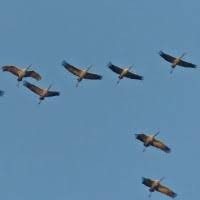Opis
The large open areas of industrial peat with sprinkled areas that have already been rewetted offer thousands of cranes a peaceful and safe sleep places in the Great Moor near Uchte. In autumn 2008 11,000 cranes stayed here - the biggest number determined for this area. The large-scale cultivated land in the vicinity of the Great Moor is well suited as a food area for the birds. Cranes have also been breeding in Uchter Moor since 2009. Hiding in trouble-free, wet moorland, they start building their nest in March. The incubation period for the two eggs is approximately 30 days. Just a few days after hatching, the whole family makes small excursions through the bog and the edge of the bog.
Szczegóły
Dostęp
You can visit the north and south side of the Uchter Moor. See for parking places and location of the watchtowers the map.
Teren i siedlisko
WrzosowiskoWarunki
Płaski , Otwarty krajobrazTrasa dookoła
NieCzy luneta będzie przydatna ?
Może być przydatnaUdany sezon obserwacyjny
Wiosna , JesieńNajlepszy czas na wizytę
Jesień , Jesienne migracjeTrasa
Droga utwardzona , Droga nieutwardzonaPoziom trudności szlaku pieszego
ŁatwyDostępne
PieszoCzatownia/platforma obserwacyjna
NieDodatkowe informacje
The areas around Diepholz are famous for the gathering of żuraw every autumn. Diepholz has 24,000 hectares of peat bogs in eleven different areas. Between the areas are small villages and lots of corn fields and grassland. Most visitors are gathered around a few large observation towers, and the rest of the area is usually quiet. The thousands of birds gather here in Germany during the żuraw migration to fat up for their trip to the more southern wintering grounds. During this period, the number may reach in the tens of thousands. During te day the birds are foraging (feeding) on the different corn fields in the area and in the evening they fly in great numbers to their sleeping places in the peat bogs around Diepholz. The best time of the year, with the biggest amounts of żuraw is during the last two weeks of october, and the first week in november.




